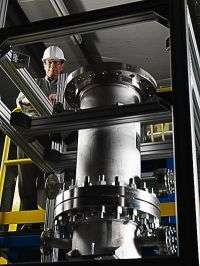Coal gasification -- myths, challenges and opportunities

There is a growing consensus that increased demand for electricity will cement coal’s place in the energy portfolio for years to come. In fact, more than half of the electricity produced in the United States comes from coal. With demand for electricity expected to double by 2050 and renewable resources still years away from offsetting increased demand, it is clear -- coal is here to stay.
But can ‘dirty’ coal be used cleanly? The answer may be a resounding yes if gasification becomes common place, researchers said today at the 2008 Annual Meeting of the American Association for the Advancement of Science (AAAS) in Boston.
“Coal gasification offers one of the most versatile and clean ways to convert coal into electricity, hydrogen and other valuable energy products,” said George Muntean, staff scientist at the Department of Energy’s Pacific Northwest National Laboratory, during his presentation at the AAAS symposium entitled “Coal Gasification, Myths, Challenges and Opportunities.”
PNNL scientists organized the symposium to provide an overview of how coal gasification can help meet the growing demand for clean energy.
“Gasification provides significant economic and environmental benefits to conventional coal power plants,” Muntean said. Rather than burning coal directly, gasification breaks down coal into its basic chemical constituents using high temperature and pressure. Because of this, carbon dioxide can be captured from a gas stream far more easily than from the smokestacks of a conventional coal plant.
“If we plan to use our domestic supply of coal to produce energy, and do so in a way that does not intensify atmospheric CO2 concentrations, gasification is critical," Muntean said. "It has the potential to enable carbon capture and sequestration technologies and play an important role in securing domestic sources of transportation fuels.”
Many experts predict that coal gasification will be at the heart of clean coal technology if current lifespan and economic challenges are addressed. One significant challenge is the historically short lifespan of refractories, which are used to line and protect the inside of a gasifier. Currently, refractories have a lifespan of 12 to 16 months. The relining of a gasifier costs approximately $1 million and requires three to six weeks of downtime.
“Gasification happens in an extreme environment so the lifespan of refractories is historically low,” said S.K. Sundaram, PNNL staff scientist. “Refractory lifespan must be increased before we can realize the promise of clean coal.”
During the symposium, S.K Sundaram highlighted two advanced gasifier models developed at PNNL that provide a scientific understanding on when and why refractories fail at such high rates. The data collected from these models could enable advanced or alternative gasification technologies to be produced. Use of these models could extend refractory lifespans by 3 years.
“Advances in modeling will help us better understand some of the key challenges associated with coal gasification – refractory durability and lifespan,” Sundaram said. “This will help reduce the capital costs of operating a coal gasifier.”
During the symposium, researchers at PNNL also highlighted advances in millimeter wave technology that could be used for real-time measurement of critical parameters (temperature, slag viscosity, refractory corrosion) inside a gasifier. The millimeter wave technology, developed at PNNL, has been used for a number of different applications, from airport security to custom fit clothing. Although in the early stages of development for this application, the technology shows promise to increase the efficiency and safety of coal gasifiers.
“Advances in gasification will help us meet demand for clean energy worldwide,” Sundaram said. “Science and technology are paving the way for cleaner coal for future generations.”
Source: Pacific Northwest National Laboratory





















